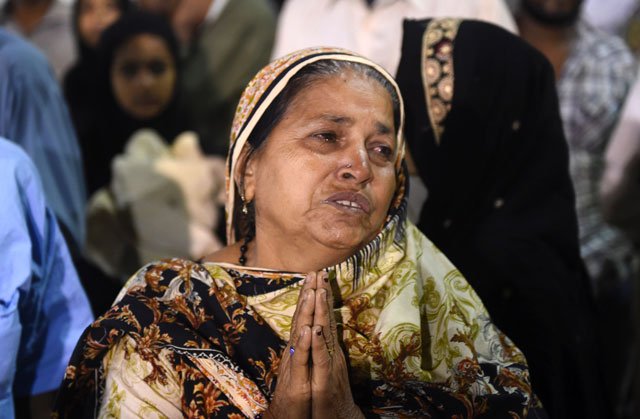
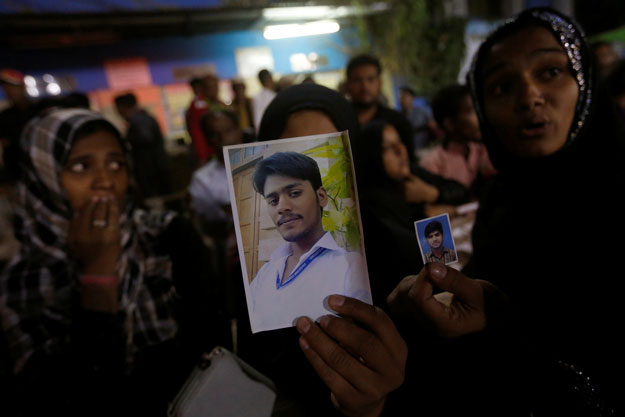 Family members show pictures of missing relatives after an explosion in at the Shah Noorani Shrine in Khuzdar, Balochistan outside a hospital in Karachi on November 12, 2016. PHOTO: REUTERS
Family members show pictures of missing relatives after an explosion in at the Shah Noorani Shrine in Khuzdar, Balochistan outside a hospital in Karachi on November 12, 2016. PHOTO: REUTERSThe blast, later confirmed to be the work of a teenage suicide bomber, hit male and female worshippers as they were dancing and chanting at the shrine of the Sufi saint Shah Noorani, some 750 kilometres south of Quetta, Balochistan.
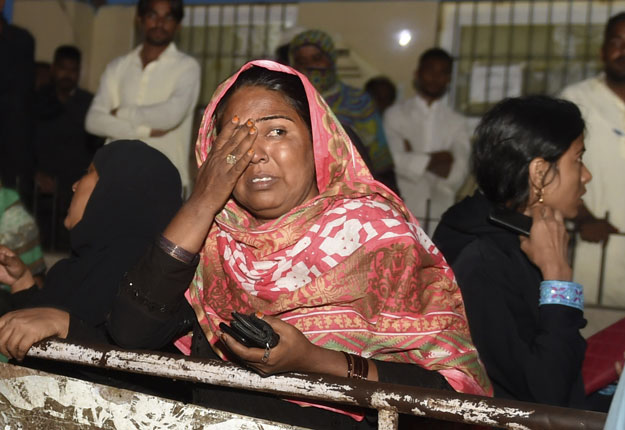 Rescuers transport an injured victim to the hospital in Karachi on November 12, 2016, following a suicide bombing at a Sufi shrine. PHOTO: AFP
Rescuers transport an injured victim to the hospital in Karachi on November 12, 2016, following a suicide bombing at a Sufi shrine. PHOTO: AFPMohammad Shehzad, a 25-year-old who had travelled in a group of 120 pilgrims, told AFP: "The pressure of the blast was so strong, people were blown away. Everyone was running, shouting and searching for families. "Children were looking for the mothers and fathers. People looking for brothers and sisters but no one was able to listen to their cries."
 Women mourn the death of relative outside of a mortuary in Karachi on November 12, 2016, following a suicide bombing at a Sufi shrine. PHOTO: AFP
Women mourn the death of relative outside of a mortuary in Karachi on November 12, 2016, following a suicide bombing at a Sufi shrine. PHOTO: AFPThe attack killed 52 and wounded more than 105 and was the fourth deadliest in Pakistan this year. Stricken survivors swathed themselves in blankets and braved the cold under open skies overnight as they made their way home.
 Woman talk on phones while gathering outside of a mortuary in Karachi on November 12, 2016, following a suicide bombing at a Sufi shrine. PHOTO: AFP
Woman talk on phones while gathering outside of a mortuary in Karachi on November 12, 2016, following a suicide bombing at a Sufi shrine. PHOTO: AFPMany had travelled hundreds of kilometres to pay their respects to the saint and seek blessings, in line with their belief in Sufism, a mystic Islamic order that worships through music and is viewed as heretical by hardline militant groups.
IS-claimed bombing kills at least 52 at Khuzdar shrine
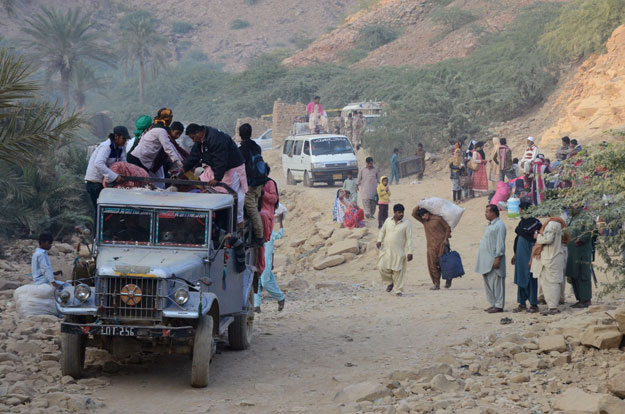 Devotees board a jeep on their return home from the shrine of Sufi saint Shah Noorani, some 750 kilometres south of Quetta, on November 13, 2016, following a suicide bomb attack. PHOTO: AFP
Devotees board a jeep on their return home from the shrine of Sufi saint Shah Noorani, some 750 kilometres south of Quetta, on November 13, 2016, following a suicide bomb attack. PHOTO: AFPUnlike at mosques in Pakistan, which often limit access to women, in Sufism both genders are permitted to take part in many rituals, though they are sometimes separated by partition walls.
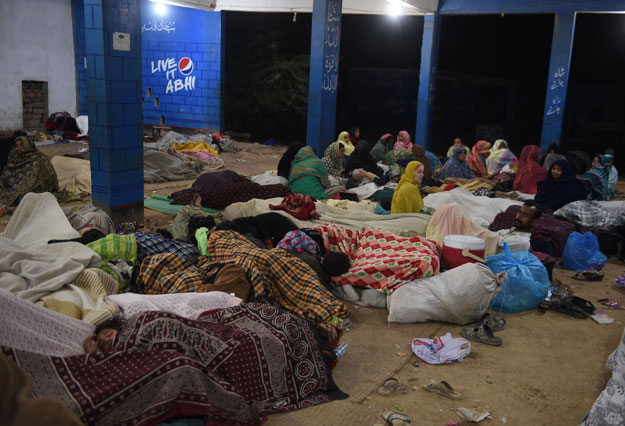 Devotees take shelter after a suicide bomb attack near a shrine of Sufi saint Shah Noorani, some 750 kilometres south of Quetta, on November 13, 2016. PHOTO: AFP
Devotees take shelter after a suicide bomb attack near a shrine of Sufi saint Shah Noorani, some 750 kilometres south of Quetta, on November 13, 2016. PHOTO: AFPWitnesses said problems were compounded by the fact that it took several hours for rescue services to reach the remote shrine, located on a hilltop in the Khuzdar district of Balochistan several kilometres away from surrounding villages, with poor mobile network coverage.
 A soldier takes picture of suicide blast site in a shrine of Sufi saint Shah Noorani, some 750 kilometres south of Quetta, on November 13, 2016. PHOTO: AFP
A soldier takes picture of suicide blast site in a shrine of Sufi saint Shah Noorani, some 750 kilometres south of Quetta, on November 13, 2016. PHOTO: AFPHafeez Ali, a 28-year-old auto mechanic, said: "We had left the area only five minutes before the attack to go and cook our dinner. From our viewpoint on a hill, we could see three whirling dervishes dancing to a drummer, as hundreds formed a circle around them. Then came the explosion.
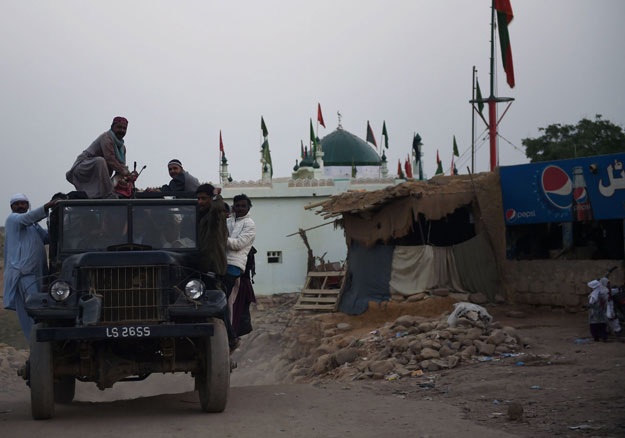 Devotees board on a jeep on their return home from the shrine of Sufi saint Shah Noorani, some 750 kilometres south of Quetta, on November 13, 2016, following the suicide bomb attack. PHOTO: AFP
Devotees board on a jeep on their return home from the shrine of Sufi saint Shah Noorani, some 750 kilometres south of Quetta, on November 13, 2016, following the suicide bomb attack. PHOTO: AFP"We realised that it was a bomb blast. Two of us rushed down and saw the bodies scattered all around -- mostly children. We also saw the drum beater dead and his exploded drum was lying nearby."
Islamic State growth
Balochistan Home Minister Sarfraz Bugti told AFP the blast was carried out by a teenage suicide bomber. "We have found body parts of the bomber which place his age at around 16 to 18," he said.
The announcement lent credence to a claim of responsibility by the Islamic State group, which released a photo overnight of the purported attacker -- a dark-skinned youth dressed in white tunic with a green backpack -- via its affiliated Amaq news agency.
It was the second major assault claimed by the Middle-East based outfit in as many months, following a raid on a police academy in the same province that killed 61 people.
Militant sources in the province have told AFP that IS, which had earlier struggled to gain a foothold in the country because of competition from already established groups, has now forged alliances with local affiliates including the anti-Shia Lashkar-e-Jhangvi group.
Pakistan has been battling a home-grown militant insurgency since shortly after the US-led invasion of Afghanistan in 2001 forced the remnants of the Taliban and al Qaeda to flee across the border.
Overall levels of violence have dropped in recent years following major military operations in the tribal areas mainly targeting the Pakistani Taliban, but it now appears that new threats are emerging.
Amir Rana, an expert on militancy, said: "It seems that IS has found an ally in Pakistan, which is probably the al Alami faction Lashkar-e-Jhangvi. The group is organising the scattered factions of sectarian outfits and Taliban factions, across the country, but it is much organised in Balochistan and Sindh."
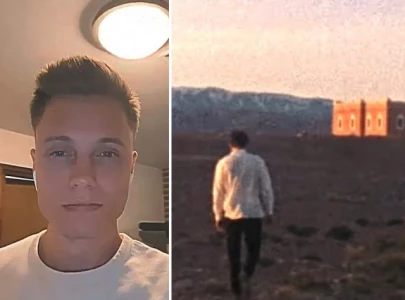


1719211536-0/BeFunky-collage-(81)1719211536-0-165x106.webp)



















COMMENTS
Comments are moderated and generally will be posted if they are on-topic and not abusive.
For more information, please see our Comments FAQ